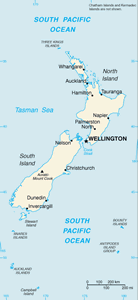The Geography of New Zealand
The Geography of New Zealand
New Zealand Geography
Location: Oceania, islands in the South Pacific Ocean, southeast of Australia
Geographic coordinates: 41 00 S, 174 00 E
Map references: Oceania
Area: total: 268,680 sq km land: 268,021 sq km water: NA note: includes Antipodes Islands, Auckland Islands, Bounty Islands, Campbell Island, Chatham Islands, and Kermadec Islands
Area - comparative: about the size of Colorado
Land boundaries: 0 km
Coastline: 15,134 km
Maritime claims: territorial sea: 12 nm contiguous zone: 24 nm exclusive economic zone: 200 nm continental shelf: 200 nm or to the edge of the continental margin
Climate: temperate with sharp regional contrasts
Terrain: predominately mountainous with some large coastal plains
Elevation extremes: lowest point: Pacific Ocean 0 m highest point: Aoraki-Mount Cook 3,754 m
Natural resources: natural gas, iron ore, sand, coal, timber, hydropower, gold, limestone
Land use: arable land: 5.54% permanent crops: 6.92% other: 87.54% (2005)
Irrigated land: 2,850 sq km (2003)
Natural hazards: earthquakes are common, though usually not severe; volcanic activity
Environment - current issues: deforestation; soil erosion; native flora and fauna hard-hit by invasive species
Environment - international agreements: party to: Antarctic-Environmental Protocol, Antarctic-Marine Living Resources, Antarctic Treaty, Biodiversity, Climate Change, Climate Change-Kyoto Protocol, Desertification, Endangered Species, Environmental Modification, Hazardous Wastes, Law of the Sea, Marine Dumping, Ozone Layer Protection, Ship Pollution, Tropical Timber 83, Tropical Timber 94, Wetlands, Whaling signed, but not ratified: Antarctic Seals, Marine Life Conservation
Geography - note: about 80% of the population lives in cities; Wellington is the southernmost national capital in the world


